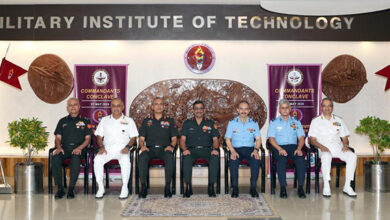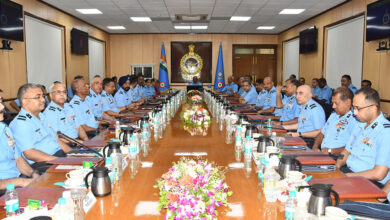All new MRCA to be purchased from one company
India Strategic had an informative interview session with the Indian Air Force (IAF) Chief of Air Staff, Air Chief Marshal Fali Homi major, on the eve of the Paris Air Show. This is the first part of the exhaustive interview, aimed at the IAF’s Multi Role Combat Aircraft (MRCA) requirement. The 2nd part, on other issues, will be carried in the next edition.
New Delhi. Chief of Air Staff Air Chief Marshal Fali Home Major says that the much-awaited Request for Proposals (RfP) for the Indian Air Force’s Medium Multi Role Combat Aircraft (M-MRCA) should be issued within two months.
He said that most of the issues concerning the RfP had been examined and that he did not foresee any more delay barring the procedural process to clear it now under way.
A confident and smiling Chief, as the Chief of Air Staff is traditionally and affectionately described in the Air Force family, also said that all the 126 combat jets will be acquired from one vendor, or company and country. “The world’s single biggest fighter jet order yet jet will go to one supplier.
” There have been rumours that the government could buy these jets from two or three countries due to “diplomatic considerations” – to keep everyone happy.
As for the RfP, he said that although the process of issuing tenders had taken time, “all possible issues” are being verified in advance to ensure that there are no delays later.
“The first squadron of 18 new jets should be inducted within five years (by 2012),” he said.
In separate interaction with India Strategic, senior officers of the Ministry of Defence (MoD) also indicated the same time period, pointing out that the new acquisition procedures under the Defence Procurement Policy (DPP) 2006 would facilitate time-bound technical evaluation by the IAF followed by financial clearance by the Ministry.
“After issuance of tenders – around July – the laid down procedure will be followed which is very objective, transparent and time-bound,” Air Chief Marshal Major said.
He agreed that multi-vendor acquisition would mean more direct purchase of the aircraft, addition to the inventory, and thereby problems in the indigenous manufacture process. That would also make the aircraft more expensive perhaps.
He said that Transfer of Technology (ToT) to build indigenous aerospace capabilities was an important aspect of the acquisition exercise. The single vendor chosen to supply the MRCA will have to facilitate that.
He observed that “we want to reduce the inventory to three types” and that the IAF of the future should have the indigenous Tejas Light Combat Aircraft (LCA) as a light fighter, MRCA as a medium combat jet, and the Sukhoi SU 30 MKI for intensive, long-range and heavy-duty Air Dominance missions.
In the past, the Indian Air Force had a variety of aircraft. This did not help in engineering and technical terms, and a number of spares had to be kept here and there. With the reduction in inventory to only three types in the coming years, it will be much easier to manage their maintenance and it would also be easier to keep track of expensive and vital spares.
Air Chief Marshal Major said that there was no plan at the moment to increase the number of MRCAs for acquisition beyond 126 but “a review after induction, based on cost benefit analysis, is of course possible in future”. Recent reports in the aviation market have been indicating that this order is likely to be revised to 200.
Air Chief Marshal Major said that “After issuance of tenders – around July – the laid down procedure will be followed which is very objective, transparent and time-bound.”
He described the SU30-MKI is a near fifth generation fighter giving IAF substantial strategic reach.
Although this aircraft is still in the process of acquisition, future upgrades for it are already being planned to ensure that it retains “its cutting edge” over the coming decades.
The MRCA and LCA would be given a technological edge on similar lines and the key to the acquisition of the new MRCAs, from among a choice of six vendors, would be the “technology and multi-role capability. ”
It may be noted that with the release of the RfP imminent, all the six contenders are getting ready to nosedive at full throttle with their campaign maneuvers into the Indian capital.
The aircraft in the fray are the US Boeing F18 Super Hornet Block II, Lockheed Martin F16), Swedish Gripen, French Rafale, European Consortiums’ Eurofighter Typhoon and Russian Mig 35.
Excerpts
India Strategic: Steady depletion of IAF’s fleet strength is one question that is now bothering everybody, legislators, media and the public alike. Except for the SU 30 MKIs, IAF has no other aircraft acquired over the last 25 years. There is no substitute for numbers, keeping in mind that IAF was never given the sanctioned fleet strength of 45 squadrons. How are you managing with existing numbers? The process of phasing out the aircraft is now faster than the process of replacement. How do you plan to maintain the force levels, and improve upon them? That in fact, is the proverbial need of the hour at the moment.
ACM Major: Yes, the IAF’s force level management programme has been negatively impacted by delays in procurement. Despite the induction of additional Mirage 2000, Jaguars and SU 30 MKI aircraft in the recent past, the net acquisitions have not kept pace with the phasing out of older fleets at the end of their service lives.
The IAF has planned induction of additional SU 30 MKI and (new) MMRCA to arrest the reduction in the strength of combat squadrons. The RfP for M-MRCA will be issued as soon as the due process is complete. Also, besides acquisitions to overcome the shortage, we are focusing on upgrade of the existing inventory (aircraft, systems and weapons) to make it more relevant as well as the use of force multipliers.
Additional Flight Refueler Aircraft (FRA), AWACS, precision weapons and newer systems all around – from ECM (Electronic Counter Measure) suites to networking and communication, will all put together, enhance the operational readiness of what we have.
India Strategic: Published reports indicate that more than 80 percent of the 1960s and 1970s generation Mig 21s have been phased out, and the same is true for Mig 23s and Canberras while Mig 27s are nearly on their way out (perhaps by next year?). Has the delay in the acquisition of the 126 MRCA (as replacement) resulted in the need for higher numbers? Unconfirmed reports say that these could go up to 200-plus.
ACM Major: Combat aircraft have a specified life and are phased out at the end of their calendar life or Total Technical Life (TTL), as specified by the manufacturer. While the Mig 23 BNs will be phased out in a couple of years, the upgraded Mig 21 (Bison) and upgraded Mig 27 aircraft will be operational for at least another decade.
The procurement procedure for the 126 M-MRCA is in progress and there is no plan to increase this number. A review after induction, based on a cost-benefit analysis, is of course possible in future.
India Strategic: The most-asked question perhaps: What is happening to the RfP to replace the large number of old aircraft?
ACM Major: The procurement action is in progress as per the laid-down procedures. The magnitude, the complexity of the project, is so large that there are a lot of novel methods and considerations involved; hence all the possible issues are being verified before the RfP is issued. The RfP is likely to be issued shortly.
India Strategic: Ministry of Defence Officers say that once the RfP is out, it should not take more than 3 to 5 years to complete the induction process – unlike the past – thanks to the DPP 2006, which should help speed up procedures, both within the IAF and MoD. Assuming the RfP is out this year, how do you envisage the process from then onwards.
ACM Major: Steps for capital (equipment) procurement are clearly enunciated in the DPP 2006. After issuance of RfP, the laid down procedure will be followed, which is very objective, transparent and time-bound.
India Strategic: There is a rumour that the order for the 126 MRCA could be split into three to “make everybody happy” due to the link between defence and diplomacy. It does not make sense to us but if it is just a rumour, then it is best set aside. If you are looking at Transfer of Technology (ToT), and meaningful offset advantages, dividing the procurement into three, or even two, suppliers is not going to be practical.
ACM Major: All issues related to procurement are analysed in a comprehensive manner at various levels to ensure that the best option is exercised. Factors like technology offered, initial cost, life-cycle cost, transfer of technology, and offsets will play a crucial role in the final decision.
India Strategic: You have a reasonably large choice from among half a dozen types. Kindly spell the broad Air Staff Requirements (ASR) and how are you going to choose one of those magnificent machines? What is the emphasis on?
ACM Major: The Air Staff Requirements are secret documents and cannot be revealed. However, I can assure you that the ASRs are designed to be contemporary and futuristic, and also have a cost-benefit angle.
In a generic sense, we want a medium weight, multi role combat aircraft that can undertake air defence, ground attack, maritime attack (anti-ship) and reconnaissance roles with ease.
We want the aircraft to have adequately long range and endurance to meet our operational requirements. Extension of range through air-to-air refueling is also desired. Ease of maintenance and low life cycle costs would form part of the selection criteria.






